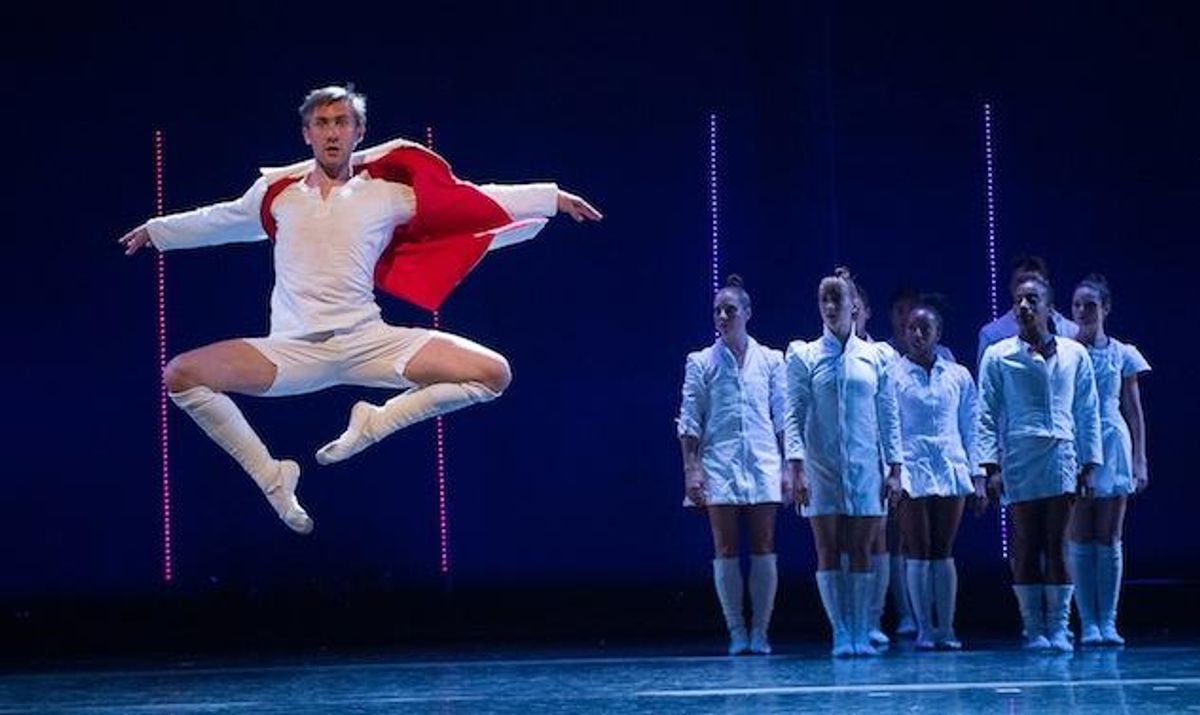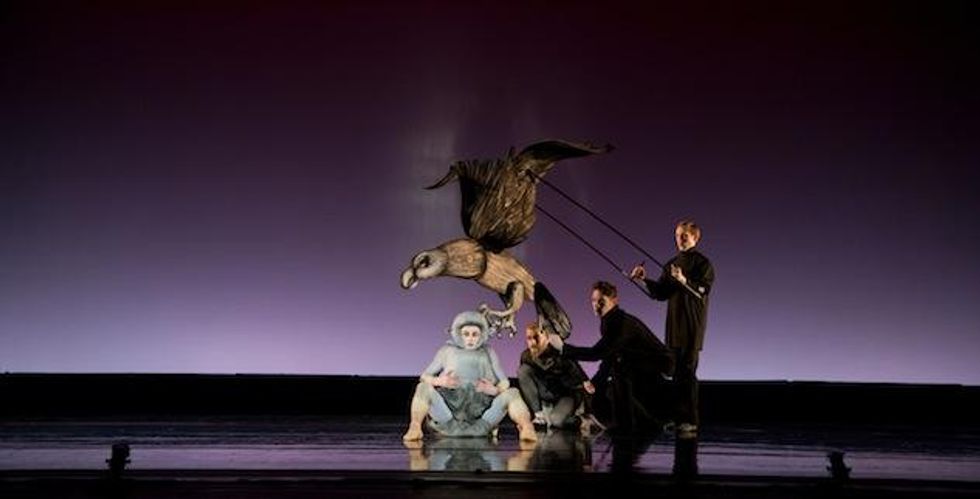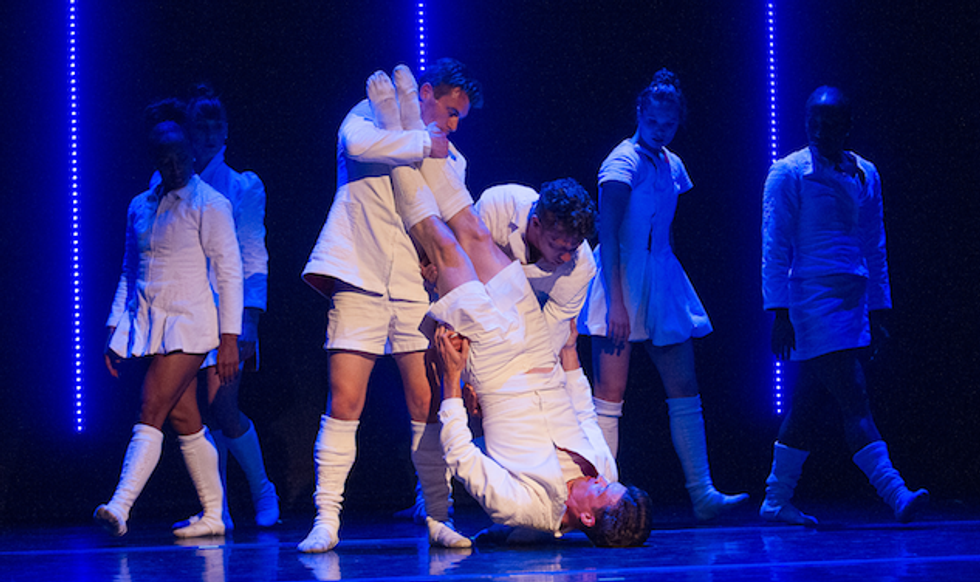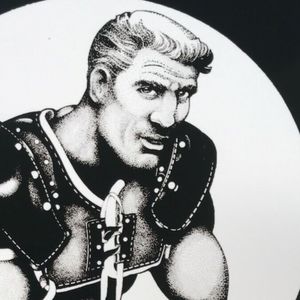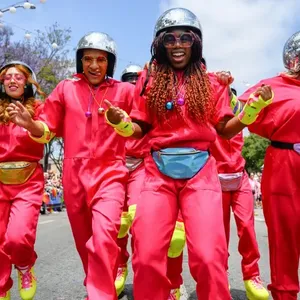Brett Perry in Trey McIntyre's "Mercury Half-Life" at Jacob's Pillow Dance Festival | Photo by Christopher Duggan
"It's just so sad," said the woman in front of me, her voice catching and tears threatening to breach their dam. It wasn't the dance itself that got her all worked up, it was the fact that, when the curtain came down on Sunday afternoon at the Ted Shawn Theater, a converted barn on the historic wooded grounds of the Jacob's Pillow Dance Festival, the Trey McIntyre Dance Project would be no more.
From its inception as a pickup company in 2005, and then as a full-time troupe, TMP and its namesake, 44-year-old choreographer Trey McIntyre, have been defying the often-staid conventions of dance in America today. They've built a devoted following in the process, hence such an emotional response to its decision to close up shop.
The concept of disruption comes to mind when thinking of TMP's legacy. Granted, "legacy" is strong word for a 10-year-old contemporary dance troupe--but it fits. The buzzword of the current startup era, "disruption" generally refers to the way (mostly tech) entrepreneurs are upending traditional assumptions, business models and industry best practices. Dance rarely can be said to borrow from the innovations of business (shame, that) but if anyone has embodied the spirit of disruption in the dance world, it's McIntyre.
Perhaps McIntyre's greatest coup was relocating his company to Boise, Idaho, in 2008. Many are still suffering whiplash from the double take. Serious dance companies belong in New York, conventional wisdom goes, and the Midwest won't embrace such an elitist art form, especially not one led by a gay choreographer.
But embraced they were. TMP thrived in Boise, working its ass off to engage with the community, performing at high school halftime shows and in local restaurants, for example. Residents responded because it was clear TMP genuinely cared about their audiences and about integrating dance into the city's cultural fabric - which is characteristic of McIntyre's choreography as well.
Trained in classical ballet technique, he's as likely to employ a medley of Queen songs in his dances as a Shostakovich piano trio--both of which accompanied the company's final performances this past weekend at the Pillow.

John Speed Orr in 'The Vinegar Works: Four Dances of Moral Instruction"'at Jacob's Pillow Dance Festival; Photo by Trey McIntyre
The Vinegar Works: Four Dances of Moral Instruction, which opened the program (set to the Shostakovich), was populated by ghosts and ghouls, but the fun kind, like a tour through Disneyland's Haunted Mansion. The towering figure of Death-- scarf permanently frozen off to the side in midair, draped in a long black cloak that opened into a tent--presided over vignettes inspired by the playfully diabolic stories of Edward Gorey.
"Tim Burton's Fantasia," was how my partner described it, which aptly sums it up: the dark humor, quirky characters, modern Victorian-chic and cartoonish design (meant as a compliment) wrapped in eerily splendid music. McIntyre's moves slip'n'slide from graceful and fluid to awkward and grotesque, as if moving from the world of the living to that of the dead.
In Mercury Half-Life, which occupied the second half of the program, McIntyre runs his company - all 10 of them eager and exceptionally skilled--through an obstacle course of the Queen glam-rock cannon.

Mercury Half-Life" at Jacob's Pillow Dance Festival | Photo by Christopher Duggan
In crisp whites (men in short shorts, women in short skirts, all in reversible tailored jackets that flip to red) the dancers look like a marching band-cum-cheerleading squad, which the choreography's symmetrical compositions, frequent group lifts and presentational "Look at me!" spirit supports. (An occasionally intricate duet hints at McIntyre's capacity for developing more nuanced relationships.)
Here, as in The Vinegar Works, dancer Brett Perry acts as a sort of an emcee; in the first work, he shrugs, pouts, gestures and spins with marvelous speed and precision. In Mercury Half-Life, he taps and scuffs around the stage with vim. In both, he's the consummate showman. In other words, he's like Trey McIntyre.
As with other TMP works I've seen, the program at Jacob's Pillow felt authentic in that the work is exactly what we see, no more. You don't get the impression of deeper layers or subtle commentary (on life, relationships, society, whatever) or larger metaphors. It is dance as entertainment, which sounds obvious and easy but, on the concert stage and in the world of contemporary dance, is actually rare and difficult.
"Legacy" is perhaps not the right word for McIntyre: Though he's walking away from managing a full time company (citing burnout), he's pursuing other artistic endeavors, like writing and filmmaking, and will continue to choreograph on a freelance basis for other companies. So his legacy is still TBD.
But with the Trey McIntyre Project, he taught us something about how dance can thrive in America today and disrupted the expected order of things--both in the way he established TMP, and in the way he gracefully put it to bed. It's sad but it's brave, too. Meanwhile, those deeply and emotionally invested in dance eagerly await his next startup.
